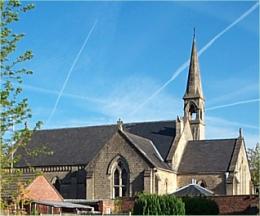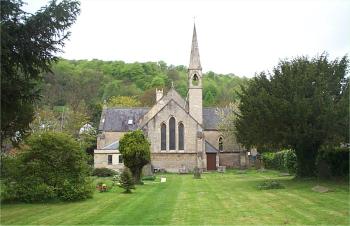To Her Majesty's Commissioners for Building New Churches
And also to the Ecclesiastical Commissioners for England
And to the Society for Promoting the Employment of Additional Curates
in populous places
The Memorial of Henry Vizard of Dursley, in the County of Gloucester,
Gentlemen:
Dursley is an important market town but there has not been a resident
rector for the last forty years, the Archdeacons having held the preferment
of greater value. The Rectory House is very old and unfit so that the
parochial duties have been performed by curates.
The tithes and glebe of the Rectory are £280 pa gross value
but high taxes reduce this to £220 pa from which two curates salaries
are to be deducted.
The parish is small - 750 acres of pasture and 250 acres of beech
woodland. The population in 1831 was 3226 but in consequence of the
almost total failure of the woollen cloth trade, the population in 1841
was only 2763 with 168 people in the Union Workhouse.
The good parish church (St James') is capable of holding 1000 persons.
It is wholly fitted with pews except for a gallery for the Sunday School
children. Of the 123 pews, 109 are private pews for families of gentlemen
and tradesmen; the remaining 14 pews will hold 150 people with 150 children
in the gallery so that there is room for only 300 poor, even though
their numbers are 2/3 of the population, about 1800.
Many of the pews are appropriated to Dissenters as owners of houses
but they do not occupy them; the curates do not take it upon themselves
to do anything about it. This scanty accommodation for the poor, the
small tradesmen and mechanics has occasioned the building of four dissenting
meeting houses though the decrease in trade in the town has caused two
of them to close down.
In 1842, Henry Vizard as the principal proprietor of the property
in the parish took steps to commission a Chapel in Dursley to alleviate
the shortage of accommodation. At a meeting under the patronage of the
Bishop of Gloucester, £300 was voted towards building the chapel
and £200 towards an endowment. Donations through the Bishop amounted
to £125 for building and £500 for endowment.
A committee was set up consisting of:
- Rev Sir George Prevost, perpetual curate of Stinchcombe
- Rev George Madan, vicar of Cam
- Rev Benjamin Robert Perkins, vicar of Wootton-Under-Edge
- Rev John Maynard, curate of Dursley
- Henry Vizard
- The Archdeacon, as rector of Dursley, but as he resided 25 miles
away he never acted or in any way interfered with the project.
A grant of £200 was obtained and local residents and inhabitants
raised £1,270. Henry Vizard then gave half an acre for the site
of the Chapel and burial ground together with £250, the necessary
stone from his quarries for the building and £150 for the warming
apparatus and lighting the Chapel. The plans, fees, building and furniture
came to £1,300, leaving a deficiency of £30. The repair
fund of £20 should be £100 to be adequate, requiring raising
another £80. The total deficiency was therefore £110.
The Chapel was fitted for 350 free places and consecrated on 16
Apr 1844. The poor are much pleased and call it their church.
Dursley had one curate to run the parish until the establishment
of the Union Workhouse in 1838. Its presence required a second curate
to share the Union and Church services. The Union Guardians objected
to the transfer of their services to St Mark's. Thus the extra services
at St Mark's required the preaching of six full services weekly as well
as attending the sick and infirm who are numerous because the Union
covers eleven parishes with a population near 20,000 together with the
schools numbering 200 children and the diocesian school of thirty sons
of the middle classes in addition to the performance of Baptisms, Marriages
and Burials. A remedy should be sought to lessen their laborious duties.
The best means to accomplish this is to split the parish into two
according to the limits of the two manors. The Parish Church would retain
the Rectory and the Union Workhouse. The new chapel would be in the
centre of population of the remaining part.
The memorialist, having lived in Dursley for 70 years, has experienced
the need for a resident Rector. The Bishop is disposed to approve but
the Archdeacon, although his pecuniary interests were not affected,
refused. So what steps can be taken? The memorialist will donate £1,000
to increase the endowment of the Chapel, having already given £600.
He has bought a house, garden and paddock adjacent to the Chapel providing
accommodation for a gentleman of property. Should this not be suitable
he could provide a money endowment in lieu.
To prove his sincerity, he mentions that he had previously contributed
£1,000 in purchasing, building and endowing the national and infants'
schools. He has bought a house and garden near the new Chapel and built
a large school room costing £800 and left £1,000 in his
will to support this Diocesian school for the middle classes. This school
was established in 1839 with a hope that it would promote similar institutions
in other deaneries but this is the only one, to the great credit of
Dursley.
The memorialist hopes and entreats that the objects he realised,
namely, the formation of a District in the Parish of Dursley to which
the new chapel shall be attached with a sufficient endowment for the
support of a minister in dependant of the Rector of Dursley. In addition
that the deficiency in the Fund for Repair may be met by a grant.
Signed: Henry Vizard





